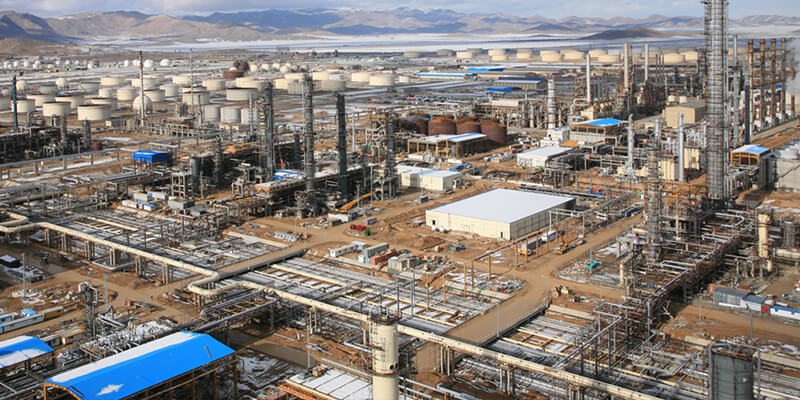Updated: September 2022
Exposing the mullahs’ nuclear weapons program- An unrelenting untold undertaking by the Resistance

Overview
Developing or procuring nuclear weapons is a key pillar of the Iranian regime’s survival strategy. The Iranian regime initially declared it would not pursue nuclear energy, and it abandoned elements of the existing nuclear program, such as the Bushehr nuclear power plant, which was already under construction by German firms at the time of the Shah.
However, the mullahs soon realized that a young and vibrant Iranian society and a burgeoning democratic opposition represented serious challenges to their backward rule. Unable to lead Iran and manage a population that was newly freed from monarchist oppression, the mullahs adopted a new strategy that ultimately led them to pursue nuclear weapons technology as an insurance policy against their eventual downfall.
First, they instigated war and strife in neighboring countries under the pretense of exporting the revolution. This was accompanied by severe repression at home under the banner of religious authorities. The pursuit of nuclear weapons capability formed the last of three pillars that the regime’s key officials deemed necessary to maintain their grip on power.
Nuclear weapons would also support the regime’s pursuit of regional hegemony and its intention to blackmail foreign interlocutors, secure economic and political concessions, and force international acceptance of the mullahs’ rule.
Of course, The regime has publicly insisted that its nuclear activities are peaceful and intended mainly for energy purposes. But these claims are belied by Iran’s vast oil and gas reserves, which provide a very inexpensive energy source that some experts believe could last for the next 300 years. By any assessment, nuclear energy is not cost-efficient in Iran, and the regime would need further incentives to pursue associated technologies.
Furthermore, if the regime’s intentions were as innocent as officials have claimed, the regime would not have actively concealed the details of its nuclear program for nearly two decades. The first significant challenge to that concealment came from the People’s Mojahedin Organization of Iran (PMOI/MEK) in August 2002, when intelligence reports from the group revealed the existence of the Natanz uranium enrichment site and the Arak heavy water facility. Subsequent revelations unveiled the extent to which the regime’s clandestine nuclear weapons work had advanced, and this triggered inspections by the International Atomic Energy Agency.
That, in turn, prompted further action by the United Nations Security Council, without which the Iranian regime would have surely obtained a nuclear weapon by now, and the fate of the Middle East would have been forever altered. The Iranian Resistance is proud of having contributed to this outcome, and it remains committed to the historic task of preventing an aggressive, virulently sectarian, and repression theocracy from developing weapons of mass destruction and using them to threaten its own people, the surrounding region, and the world.
The role of the Iranian resistance in revealing the regime’s nuclear program
The Iranian regime started its drive toward nuclear weapons in 1983. From the outset, it was evident to the Resistance that the mullahs would pursue this goal at astronomical cost and to the detriment of the Iranian people. The campaign to expose the nuclear weapons program required considerable resources and entailed a great deal of risk as Resistance operatives obtained, verified, and disseminated information.
The MEK relied on a vast network of sources in the Iranian regime’s civilian and military institutions as activists scrutinized the nuclear program and its various elements from 1991 onward. Over three decades, the MEK has made more than one hundred revelations of secret sites, projects, procurements, and key figures involved in the regime’s nuclear program, often in the face of incredulity and annoyance by the world powers seeking accommodation with the regime. However, that incredulity has generally vanished as evidence emerged to corroborate the Resistance’s warnings.
Those warnings concern various aspects of the nuclear project, including enrichment, bomb components, and missile delivery systems. The MEK’s information leads to no other conclusion than that The regime has worked systematically on various stages of weaponization, intending to obtain both a nuclear warhead and the means of delivering it to distant foreign adversaries.
The mullahs have invariably responded to these revelations by targeting both the Iranian people and the international community with false narratives backed up by stage-managed demonstrations, destruction of evidence, and so on. At several critical junctures, the regime tried to further deceive the international community and the IAEA by altering the focus of its work but continuing the nuclear weapons project in a different form. But the Iranian Resistance has repeatedly interfered with those plans by obtaining details of the new strategy and exposing the regime’s latest plots.
International attention to those findings has been inconsistent, but various experts on Iranian affairs and intelligence gathering have highlighted the value of the Resistance as a source of information about developments that may be occurring outside of public view from the West.
Frank Pabian, a senior adviser on nuclear nonproliferation at Los Alamos National Laboratory in New Mexico, was quoted in a 2010 New York Times article as saying of the MEK, “They’re right 90 percent of the time.” And in an earlier interview with the same publication, a senior UN official declared, “This organization has been extremely on the mark in the past. They are a group that seems to be privy to very solid and insider information.”
Furthermore, then-US President George W. Bush cited the Resistance in a 2005 press conference and emphasized their disclosures had had a significant impact on the political will of the Western world where Iran’s nuclear ambitions are concerned. Those ambitions had been exposed, he said, “not because of their compliance with the IAEA or NPT, but because a dissident group pointed it out to the world … And as a result of those suspicions, we came together with friends and allies to seek a guarantee that they wouldn’t use any nuclear program to make weapons.”
(At 7:45 of the clip)
Key Dates and Select Resistance Disclosures
- June 1991: During a trip to Washington, DC, Mohammad Mohaddessin, the Chair of the Foreign Affairs Committee of the National Council of Resistance of Iran, exposed that Iran had begun working on a nuclear weapon.[1] He revealed that the regime’s preliminary nuclear facility is located in Mo’alm Kalaye (northern Qazvin, 120 kilometers northwest of The regime). The top-secret project was code-named “Great Plan” (also known as the “Alamout Plan”), and its initial budget were $200 million. According to the Resistance information, the Islamic Revolutionary Guards Corps (IRGC) relocated the local inhabitants to clear the area for the construction of this site. The Iranian Resistance made several other revelations in 1992 and exposed other plans by the regime.
- October 1992: The Iranian Resistance revealed that the regime had bought three nuclear weapons from Kazakhstan. According to the information obtained from inside the Iranian regime, the warheads were paid for but had not been delivered yet. The Kazak Ambassador to Washington (who was in charge of its nuclear program in 1992) confirmed in an interview on November 2, 1996, that the regime had attempted to buy nuclear weapons, but the shipment was stopped prior to the delivery.

Arak heavy water facility
- August 14, 2002: In a press conference in Washington, the NCRI revealed the existence of two secret sites (a uranium enrichment site in Natanz and a plutonium-producing heavy water facility in Arak) and details of the regime’s nuclear activities, which had remained secret for 17 years. Information on the Natanz site included the existence of two 25,000 square meters of underground halls. Eventually, international pressure forced the Iranian regime to show the two sites to the IAEA, and the big secret of the mullahs’ nuclear program was exposed. The revelation was a game changer in the Iranian regime’s pursuit of nuclear weapons.

Uranium enrichment site in Natanz
- February 20, 2003: The NCRI exposed the Kala-Electric site in Abali, The regime Province. This site was functioning under the guise of a clock manufacturing company and was used for secret testing of assembled centrifuges. The regime changed the building’s entire appearance to hide its true nature. After months of pushing, when IAEA gained access to the site, particles of highly-enriched uranium were also found at the site, prompting many questions about the nature of the mullahs’ nuclear program.
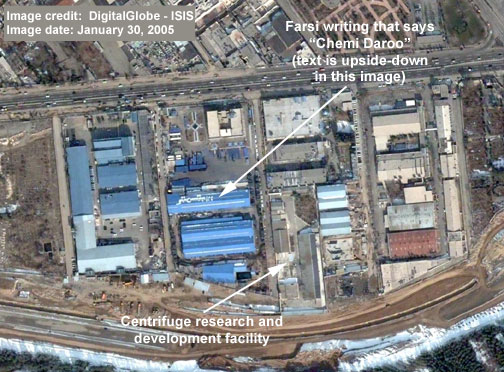
- May 27, 2003: The NCRI exposed the Iranian regime’s research on using Laser for a weaponization aspect of the nuclear program. The research was conducted at the Lashkarabad site in the vicinity of Karaj (west of Tehran). IAEA inspectors verified this when they visited the site on June 2004. The regime was eventually forced to stop the work at Lashkarabad.
- December 20, 2005: In a press conference in Paris, Mohammad Mohaddessin revealed details about a secret nuclear facility and an underground tunnel used for nuclear projects in the vicinity of Qom (central Iran). He noted that construction had begun in 2000 by a specialist engineering division of the IRGC. Nearly four years after the NCRI’s press conference, US President Barack Obama, British Prime Minister Gordon Brown, and French President Nicolas Sarkozy confirmed the existence of the same secret site, Fordow. Their joint press conference on September 25, 2009, took place only after Iranian authorities acknowledged its existence to the IAEA, recognizing that the NCRI’s revelations had rendered Fordow an open secret.

- December 23, 2006: The passage of UN Security Council Resolution 1737 imposed sanctions on 22 individuals and entities who had played significant roles in the Iranian regime’s nuclear and missile programs. Fifteen of these, or 70 percent, had been identified by the NCRI between 2003 and 2005.
- February 20, 2008: In a Brussels press conference, the NCRI exposed the research and work on a nuclear warhead in Nouri Industries of Hemmat Missile Industrial Group. The IAEA subsequently made some corroborating evidence available to member states, including a video clip of a re-entry vehicle for the Shahab-3 ballistic missile.

- September 24, 2009: In a press conference in Paris, the NCRI exposed the location of research and development related to detonators for nuclear weapons. The research center and surrounding area belonged to an entity solely responsible for this aspect of the nuclear program, namely the “Research Center for Explosion and Impact.” Known in Farsi as Markaz-e Tahghighat va Tose’e Fanavari-e Enfejar va Zarbeh and abbreviated as METFAZ, the center is affiliated with the Ministry of Defense. Its site on the banks of the Jajrood River, east of Tehran, was named for the nearby village of Sanjarian. As well as designing high-explosive detonators, METFAZ was actively manufacturing components for those systems at the time of the revelation.

• April 21, 2017: In a press conference in Washington, the NCRI noted that METFAZ had moved its main experiments to a new location, which it was trying to keep secret. The new location. Codenamed Pazhouheshkadeh, or Research Academy, the facility is located at Plan 6 of the Parchin site in eastern Tehran.
• May 7, 2019: The Institute for Science and International Security and the Foundation for Defense of Democracies released the findings of a joint study titled “Shock Wave Generator for Iran’s Nuclear Weapons Program.” The report confirmed the NCRI’s revelations from 2009, citing satellite imagery as proof that “the NCRI-identified site at Parchin is a high explosives research and development and manufacturing site.”
• January 5, 2020: The regime announced the conclusion of its “fifth step” in violation of the 2015 nuclear deal between Iran and six world powers, formally known as the Joint Comprehensive Plan of Action. The process had ostensibly begun in response to the US withdrawal from that agreement in 2018, but it continued despite protests from European powers that are intent on upholding the agreement. Iran has remained in violation of all major provisions ever since, and the speed with which it resumed higher-than-permitted levels of uranium enrichment has raised additional questions about whether the regime had ever truly downgraded its nuclear infrastructure in the first place.
• August 26, 2020: The IAEA finally gained access to an IRGC-controlled site north of Abadeh on this date, approximately 17 years after the first known high-explosive tests were carried out there under the project name “Marivan.” In the interim, the site had become associated with METFAZ activities, and the NCRI had revealed details of clandestine, nuclear-related projects that took place there. As a result, the IRGC recognized the risk of broader exposure and endeavored to cover up evidence by razing the facilities in July 2019, continuing to stonewall international inquiries for another year.
• October 16, 2020: The NCRI issued a new report explaining that authorities in charge of nuclear weaponization had established an entirely new site in the Sorkheh-Hessar. The report specified that construction on the facility, in the midst of a ballistic missile manufacturing complex, began in 2012 and gradually became functional in 2017. As this timeline perfectly overlaps with the implementation of the JCPOA, it arguably corroborates the NCRI’s longstanding conclusion that the regime never intended to fully comply with the terms of that deal.
March 2, 2021 – The NCRI published new information about the Iranian regime’s Abadeh nuclear site.
Foxnews, March 4, 2021: As part of its findings, the NCRI said the site was first built by companies controlled by the Islamic Revolutionary Guard Corps (IRGC) and was part of a project named Marivan, which it said involved a group called METFAZ that was engaged “in the research and construction of nuclear high explosive-devices.”
August 18, 2022, NCRI-US Conference, 20 years after the revelation of the Natanz nuclear site.
Development of Entities Tasked with Nuclear Weaponization
The existence of a weaponization project definitively debunks The regime’s claims about its nuclear work being exclusively peaceful Thus, the regime has worked for three decades to hide the weaponization project, its key figures, researchers, and facilities from the eyes of the international community. Meanwhile, the Iranian Resistance has worked tirelessly to expose the regime’s weaponization efforts, expecting this would be a devastating blow to the regime’s ambitions.
The regime prevented the IAEA from accessing key experts and kept their identity secret. Weaponization projects have always been under the control of the IRGC, and subject to tight counter-intelligence regimes. And although the institution that would eventually spawn the weaponization-focused METFAZ has undergone several structural changes over the past three decades, its mission and key players have remained unchanged.
This entity began its work under the name “Physics Research Center” in late 1989. A few years later it was renamed “Amad Plan.”
On May 15, 2003, the NCRI revealed the Lavizan-Shian site in The regime. This was the headquarters of the clandestine weaponization aspects of the regime’s nuclear project. There, 17 types of experiments on various aspects of Weapons of Mass Destruction were carried out. The revelation seriously undermined the regime’s nuclear weapons project, though the extent of the impact would only be understood gradually over a period of years.
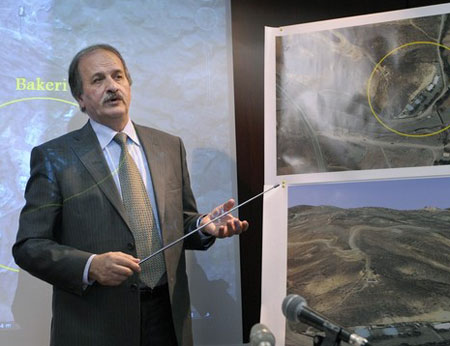
According to information gathered primarily by the MEK’s intelligence network, the Nuclear Committee of the Supreme National Security Council (SNSC), chaired at the time by Hassan Rouhani, had predicted that the IAEA would visit the Lavizan-Shian site and would find out about the secret nuclear weapons activities there. Therefore, the committee decided to demolish and relocate the site, which had been operating for 15 years. The entire area was razed, and dirt was removed to a depth of several meters. This was what the IAEA inspectors examined in June 2004.
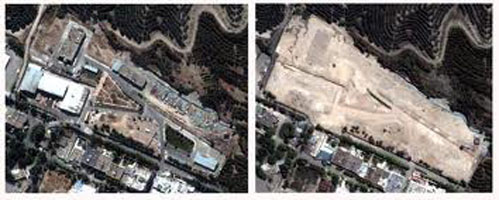
- On April 28, 2004, an NCRI press conference in Brussels exposed the Amad Plan and some of its key officials and researchers, including Mohsen Fakhrizadeh, an IRGC senior officer and the de facto head of the regime’s nuclear weaponization activities. Since then, the IAEA has issued a number of requests to interview Fakhrizadeh over his unique role in the nuclear weapons program, but the regime has vehemently rejected this request.

- In Paris, on November 17, 2004, the Iranian Resistance revealed that the weaponization project under the command of the Ministry of Defense had transferred to a new site called Shian-Lavizan 2 or Mojdeh (the name of the street it was located). The NCRI provided specifics about the new venue, including its name and the identities of more than two dozen nuclear experts who were involved in various aspects of the weaponization effort. The “Modern Defensive Readiness and Technology Center” (MDRTC) was established with Fakhrizadeh, and he remains in his role to this day.
- The Paris press conference took place just a couple of days after the conclusion of talks held in the same city between Iran and the EU3, which resulted in Europe providing a range of concessions to the Iranian regime in exchange for the promise that uranium enrichment would be suspended. The Iranian side of those talks had been led by Hassan Rouhani, and a few years later, he delivered a private speech in which he boasted that he had duped the West and that the regime had used the opportunity to complete other aspects of the nuclear cycle.
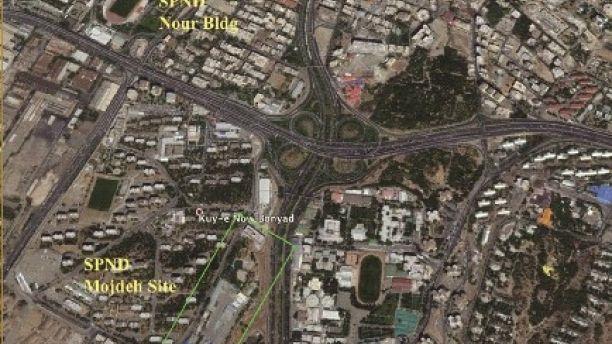
- That work was apparently completed with assistance and cover from Iranian universities, in line with a scheme that the NCRI exposed in a Brussels press conference on February 20, 2008. The Resistance found that after it had revealed the Mojdeh site, Fakhrizadeh’s office was moved to the nearby Malek Ashtar University, which is part of the Defense Ministry. Fakhrizadeh functioned as the vice president of the University and head of its Pardis.
- In a front-page story in the March 11, 2008 edition of the Washington Post, the NCRI revealed that nuclear weapons design work persisted but had migrated to universities and schools. Several of Fakhrizadeh’s deputies were reassigned to nuclear departments at ostensibly civilian schools such as Shahid Beheshti University and The regime University.
- In July 2011, the NCRI revealed the existence of a consolidated entity to work on the weaponization aspect of the nuclear project. The entity was called the “Organization of Defensive Innovation and Research” (abbreviated in Farsi as SPND). The IAEA confirmed the years-long changes in the weaponization section and the existence of SPND in its major report on Possible Military Dimensions of the Iranian nuclear program in November 2011. The US State Department put the SPND on its sanctions list for its role in proliferation of WMD on August 29, 2014.

The NCRI provided further revelations about the relocation and concealment of SPND operations in October 2013 and September 2014. And on April 21, 2017, it established that SPND and its seven subdivisions had been fully functioning after the implementation of the Joint Comprehensive Plan of Action, the nuclear deal between Iran and the P5+1, which led to the suspension of economic sanctions in exchange for promises that Iran would scale down its nuclear weapons-related activities.
Relationship between Civilian and Military Nuclear Programs
For more than 25 years, Iran’s nuclear work has consisted of two programs working in tandem. One is overt and civilian in nature and includes the Atomic Energy Organization of Iran (AEOI), universities and academic institutions. The other is a military program that operates secretly. As the Iranian Resistance has made clear over the years, the latter has always been at the heart of Iran’s nuclear activities.
The civilian program has provided a plausible logistical cover for the military program and acts as a conduit for it. The results of civilian research, training, accomplishments, and advancements have been directed to the military, which has ultimately benefitted from all such achievements. On April 28, 2004, the NCRI revealed that the military sector had recruited some 400 experts trained by the civilian sector.
The military nuclear program has gone through many changes over the years. However, it has never halted its work, and key figures in the sector have remained unchanged. To control information and prevent leaks, in addition to making use of past experience, specific companies affiliated with or belonging to the IRGC or the Defense Ministry have carried out the construction of the sites involved in the nuclear project.
An important feature of the Iranian regime’s nuclear program is that several sites and centers where nuclear related activities are conducted are situated in sprawling military complexes that also house scores of tunnels and silos. This not only makes IAEA access to these locations more difficult but also makes it possible to relocate these centers and projects to other locations within the vast military complex. As such, if it becomes necessary to relocate a project or center, it can easily be moved to a different silo or tunnel within the parameters of the military site. This makes pinpointing the exact location of nuclear research and activities more challenging, and reduces the chance of exposure.
The civilian sector has provided a plausible cover by establishing nuclear energy projects at universities. Resources and research can be used on the one hand, and their experts and talented individuals trained and recruited on the other. It has also provided a conduit for procuring dual-purpose technology and equipment that is ultimately used in the military program.
It is very telling that scores of authorities and senior officials of the two systems have exchanged positions and responsibilities over the years. It has been common practice to utilize scientists and researchers on the civilian side for the military program and to lend staff from the military side to the civilian sector to increase proficiency and expertise by utilizing each other’s facilities and centers. As such, universities affiliated with IRGC and the Ministry of Defense, Imam Hossein University and Malek-Ashtar University, have played an important role as a bridge between these two programs.
A review of the military sector’s methods in obtaining essential equipment and devices revealed that on several occasions, even the postal addresses of universities and academic centers affiliated with the civilian nuclear project had been used for procurement purposes. Some entities at the highest levels of the Iranian regime, including offices and centers affiliated with the president’s office, have been involved in smuggling or skirting sanctions to obtain illicit or dual-purpose equipment for these projects.
Revolutionary Guards’ Direct Role in Nuclear Projects
Since its inception, the nuclear weapons program was conducted under the command of the IRGC and was supervised by its top brass. A special section within the IRGC was assigned the task of overseeing scientific research and securing nuclear technology for military use. During the years while the project was pursued by the Ministry of Defense, the top commanders of the MOD were IRGC generals.
In 1987 a Pakistani nuclear scientist visited Iran while running a secret international smuggling network for nuclear technology and equipment. On at least two occasions, he was met by three commanders of the IRGC. The head of the IRGC delegation was Mohammad Salami, who was the director of the IRGC research. Salami later rose to the rank of Brigadier General and became the Director of Defense Research and Education in the MOD.
IRGC Brigadier General Ali Hosseini-Tash is one of the most prominent officials involved in the Iranian regime’s nuclear weapons program. In his position as the head of the research section of the MOD and as Deputy Minister of Defense, from February 2004 until September 2005, he oversaw the Amad Plan and reported directly to Minister of Defense Ali Shamkhani.
In February 2005, the NCRI revealed that the Iranian regime had worked on the production of a neutron initiator by using Polonium 210 and Beryllium. This project was handled by Dr. Nasser Ehsani at Malek Ashtar University, affiliated with the MOD and under the supervision of Hosseini-Tash.
The Parchin site was one of the most important locations used by AMAD. Saeed Borji, a confidant of Mohsen Fakhrizadeh and an explosives expert, was a key director of this center. He was in direct contact with the Ukrainian expert Vyacheslav V. Danilenko, who oversaw the construction of explosive chambers used in Parchin. Borji was the head of METFAZ, a subdivision of SPND. When Parchin was being used for these experiments, Hossein-Tash directly supervised the organ that worked on weaponization.
In his memoirs, entitled “National Security and Nuclear Diplomacy”, published in 2011, Hassan Rouhani wrote that Hosseini-Tash took part in the meetings of the nuclear committee of the Supreme National Security Council (SNSC) from 2003 to 2005. He wrote on page 141:
“Regarding the nuclear committee located at the secretariat of the SNSC and the organs that should play a key function, I mentioned previously that several months before I took over, this committee was active in the secretariat and members of the committee were selected by the leaders. Dr. Ali-Akbar Velayati (Supreme Leader Ali Khamenei’s representative), Dr. Kamal Kharrazi (Foreign Minister), Hojjatolislam Ali Younessi (Minister of Intelligence), Admiral Ali Shamkhani (Defense Minister), Dr. Hosseini-Tash (Deputy Minister of Defense), Gholamreza Aghazadeh (head of the Atomic Energy Organization of Iran), and I (secretary of SNSC) were members of this committee.”
While only one official from each ministry took part in these meetings, the Ministry of Defense was represented by Hosseini-Tash and Shamkhani because Hosseini-Tash had a prominent, established role in the nuclear program. This role persisted at least through August 2015, when Hosseini-Tash was identified by the Associated Press as the proposed Iranian signatory of an agreement between the regime and the IAEA regarding the investigation of the Parchin site.

Other persons with ties to the IRGC have played dual roles in the civilian and military sectors for years and have been called upon to fill whichever role was needed for the nuclear program at a given time.
Dr. Fereydoun Abbasi Davani, for instance, enrolled in the IRGC soon after it was formed, then received his MS in nuclear physics in 1987 and his Ph.D. in 2002, becoming an expert in laser technology. Abbasi has been one of the key figures in the military section, where he has played an active role since the inception of the weaponization headquarters. He has also been actively recruiting suitable individuals for the military nuclear project since the early 1990s.
By his own acknowledgment, Dayani’s real rank in the IRGC is General. He became a faculty member of the Physics Department of Imam Hossein University in 1993 and was named Dean of the Physics Department. But according to the state-run media, he rarely showed up at the university and evidently spent most of his time in another venue, i.e., the headquarters for the weaponization of the nuclear project. He became the head of the civilian sector, the AEOI, on February 13, 2000, a post he held until August 2013.

Mohsen Fakhrizadeh Mahabadi (known as Dr. Mohseni within the regime), the current head of SPND, has a similar background. He is an IRGC Brigadier General and has played various roles in the nuclear weapons program.


